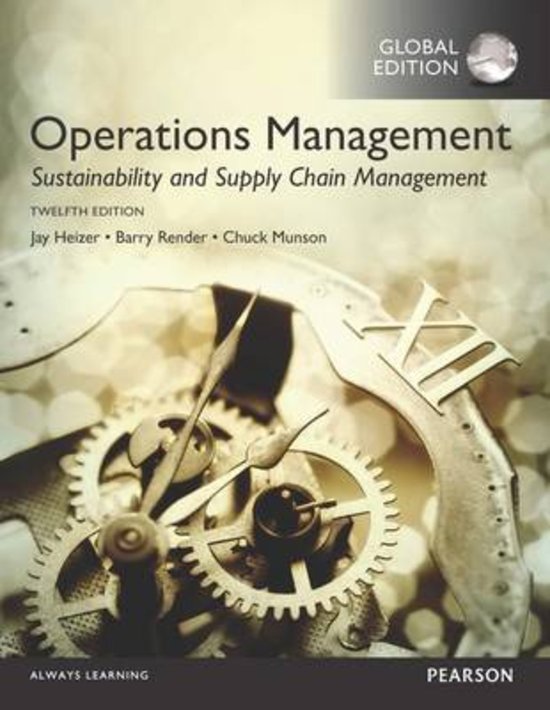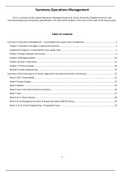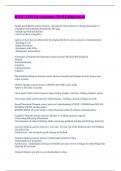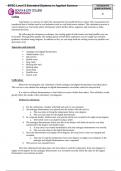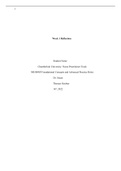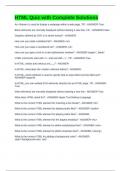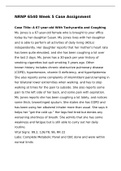This is a summary of the subject Operations Management given at Fontys University of Applied Sciences in the
International Business Consultancy specialisation. The order of the chapters is the same as the order of the lessons given.
Table of contents
Summary of Operations Management – sustainability and supply chain management........................................................ 2
Chapter 2 Operations Strategy in a global environment .................................................................................................... 2
Supplement Chapter 5: Sustainability in the supply chain ................................................................................................. 5
Chapter 5 Design of goods and services ............................................................................................................................. 6
Chapter 6 Managing Quality ............................................................................................................................................. 10
Chapter 16 Lean in operations .......................................................................................................................................... 13
Chapter 7 Process strategy ............................................................................................................................................... 16
Module B Linear programming ......................................................................................................................................... 19
Summary of the lessons given at Fontys Hogeschool International Business Consultancy ................................................. 22
Week 3 CSR / Sustainability .............................................................................................................................................. 22
Week 4 Product Design ..................................................................................................................................................... 23
Week 5 Quality .................................................................................................................................................................. 24
Week 6 Lean and Toyota Production Systems .................................................................................................................. 25
Week 7 VSA ....................................................................................................................................................................... 27
Week 8 IoT / Smart Industry ............................................................................................................................................. 28
Week 9 & 10 Management Control & Reporting Systems (MCRS) theory ....................................................................... 30
Week 11 & 12 Linear Programming – the graphical way.................................................................................................. 33
1
, Summary of Operations Management – sustainability and supply chain management
Chapter 2 Operations Strategy in a global environment
Six reasons why domestic business operations decide to change to some form of international operation:
1. Improve the supply chain: locating facilities closer to unique resources, these may be HR expertise, low-cost
labour, or raw material (auto design to California, athletic shoe production to China).
2. Reduce costs and exchange rate risk: foreign locations with lower wage rates can lower direct and indirect costs.
Trade agreements can lower tariffs (EU, WTO).
3. Improve operations: operations learn from better understanding the differences between how business is handled
in other countries, think about the Japanese inventory management, or the Germans using robots. Besides,
international operations can improve response time and customer service.
4. Understand markets: interacting with foreign customers, suppliers, competition can lead to new opportunities for
new products and services. Europe started with cell phone innovations, and then the Japanese and Indians led
with cell phone fads. It is important to use the opportunity to expand the life cycle of an existing product.
5. Improve products: remain open to free flow of ideas e.g. Toyota and BMW manage joint research and
development which leads to reduced risk, state-of-art design, and lower costs. Similarly, Samsung and Bosch
jointly produce batteries.
6. Attract and retain global talent: offer more employment opportunities. Better growth opportunities and insulation
against unemployment. Relocate unneeded personnel to more prosperous locations.
Cultural and ethical issues
Cultures and attitudes can be quite different towards punctuality, lunch breaks, environment, intellectual property,
thievery, bribery, and child labour. Despite these differences, we live in a period of extraordinary mobility of capital,
information, goods and even people.
Developing missions and strategies
Mission statements tell an organization where it is going. Factors which affect the mission are philosophy and values,
profitability and growth, public image, customers, and environment.
The strategy tells the organization how to get there. It is an action plan to achieve their mission. Strategies exploit
opportunities and strengths, neutralize threats, and avoid weaknesses.
Strategies for competitive advantage
1. Differentiation: it is concerned with providing uniqueness. Uniqueness can go beyond both the psychical
characteristics and service attributes to encompass everything that impacts customer’s perception of value. Also
characteristic for this strategy is innovative design, broad product line, after-sales service, and experience.
2. Cost leadership: entails achieving maximum value as defined by customer. A low-cost strategy does not imply low
value or low quality. Also characteristic for this strategy is low overhead, effective capacity use and inventory
management.
3. Response: is often thought of as flexible response, but it also refers to reliable and quick response. Flexibility is
matching market changes in design innovation and volumes. Reliability is meeting schedules and timeliness is
quickness in design, production, and delivery.
Issues in operations strategy
- Resources view: thinking in terms of the financial, physical, human, and technological resources available and
ensuring that the potential strategy is compatible with those resources.
- Value-chain analysis: this is used to identify activities that represent strengths, or potential strengths, and may be
opportunities for developing competitive advantage.
- Porter’s five forces model: are immediate rivals, potential entrants, customers, suppliers, and substitute products.
- Operating in a system with many external factors, from economic, to legal, to cultural.
- Constant change: the firm itself is also undergoing constant change, from resources, to technology, to product life
cycles is in flux.
2

